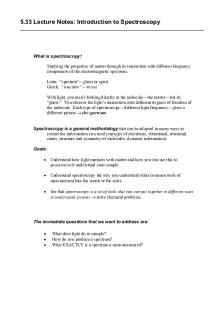Topic 4 :Spectroscopy -Exercises PDF

| Title | Topic 4 :Spectroscopy -Exercises |
|---|---|
| Course | Analytical Chemistry |
| Institution | Nanyang Technological University |
| Pages | 2 |
| File Size | 103.8 KB |
| File Type | |
| Total Downloads | 37 |
| Total Views | 167 |
Summary
Some practise questions for topic 4 Spectroscopy of module CM2011 Analytical Chemistry....
Description
CM2011 : Topic 4 Exercises
Question 1 Calculate the energy in joules of one photon of radiation with a wavelength of 1000 cm−1. 1.989 × 10−20 J
Question 2 The molar absorptivity ( ) of compound A at 450 nm is 5.25 × 103 L cm−1 mol−1. Calculate the percentage transmittance at 450 nm through a 1.5-cm pathlength cell, for a solution containing 6.13 × 10−5 M of compound A.
%T = 32.9 %
Question 3 -Tocopherol acetate is a derivative of vitamin E with a molar absorptivity ( ) of 2 × 103 L cm−1 mol−1 at 281 nm. 0.06593 g of -tocopherol acetate is dissolved in 25 mL of acetonitrile. A 0.5 mL aliquot of this solution is taken and further diluted up to 10 mL with acetonitrile. The absorbance through a 1-cm pathlength cell of the diluted solution was measured to be 0.55752 at 281 nm. Calculate the formula weight of -tocopherol acetate. 473 g mol−1
Question 4 (a) Summarise in your own words the main components of a molecular absorption spectrometer and how they function.
(b) Describe (with diagrams) in your own words the transitions (electronic, vibrational and rotational) that can occur during molecular absorption and fluorescence measurements of solution phase species.
(c) Why is fluorescence more sensitive than absorption measurements for solution phase species? 1
(d) How does a molecular fluorescence spectrometer differ from a molecular absorption spectrometer?
(e) What is the Stokes shift caused by?
Question 5 Atomic spectroscopy can be carried out in absorption and emission modes.
(a) In your own words describe how the measurements are carried out. In particular, discuss the mode of introduction of the sample into the flame, the type of flame or heat source, the hollow cathode lamp for AAS measurements, and the plasma used for emission measurements.
(b) List any advantages and disadvantages of the absorption and emission methods with respect to each other.
Question 6 (a) Calculate the percentage of sodium atoms in the excited state at temperatures of 2000 K and 3000 K, given that the degeneracy in the excited state is 2 and the energy difference between the lowest and first excited state is equal to 3.371 x 10−19 J atom−1. What is the percentage difference in the number of atoms in the excited state between the two temperatures?
5800%
(b) Why is atomic emission spectroscopy more sensitive to temperature than atomic absorption spectroscopy?
Question 7 Describe the processes that lead to broadening of atomic linewidths.
2...
Similar Free PDFs

Topic 4 :Spectroscopy -Exercises
- 2 Pages

Spectroscopy exercises SL
- 6 Pages

Spectroscopy
- 5 Pages

Topic 4
- 7 Pages

Topic 4
- 8 Pages

Topic 4
- 11 Pages

Mass Spectroscopy
- 14 Pages

Chapter 4 Programming Exercises
- 2 Pages

Chapter 4 inclass exercises
- 6 Pages

QUIZ Topic 4 - QUIZ 4
- 4 Pages

Topic 4 John Gerring
- 7 Pages
Popular Institutions
- Tinajero National High School - Annex
- Politeknik Caltex Riau
- Yokohama City University
- SGT University
- University of Al-Qadisiyah
- Divine Word College of Vigan
- Techniek College Rotterdam
- Universidade de Santiago
- Universiti Teknologi MARA Cawangan Johor Kampus Pasir Gudang
- Poltekkes Kemenkes Yogyakarta
- Baguio City National High School
- Colegio san marcos
- preparatoria uno
- Centro de Bachillerato Tecnológico Industrial y de Servicios No. 107
- Dalian Maritime University
- Quang Trung Secondary School
- Colegio Tecnológico en Informática
- Corporación Regional de Educación Superior
- Grupo CEDVA
- Dar Al Uloom University
- Centro de Estudios Preuniversitarios de la Universidad Nacional de Ingeniería
- 上智大学
- Aakash International School, Nuna Majara
- San Felipe Neri Catholic School
- Kang Chiao International School - New Taipei City
- Misamis Occidental National High School
- Institución Educativa Escuela Normal Juan Ladrilleros
- Kolehiyo ng Pantukan
- Batanes State College
- Instituto Continental
- Sekolah Menengah Kejuruan Kesehatan Kaltara (Tarakan)
- Colegio de La Inmaculada Concepcion - Cebu




